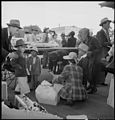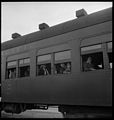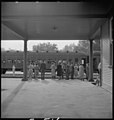User:Purpleraccoon835/sandbox
Round-Up[edit]
The Western Defense Command put out 108 Civilian Exclusion Orders to “round up” people with Japanese ancestry who lived on the West Coast. The purpose in doing this was to transfer them to temporary detention centers. Those closest to army areas were evacuated first and an effort was put in to send them to camps close to their homes. The first order went out on March 24, 1942 for 55 families closest to the attack on Pearl Harbor, who would eventually be sent to Manzanar and Minidoka internment camps.[1]
Amidst this chaotic process, civilians experienced anxiousness and excitement at the same time. The main order they had to follow was in regards to what they were allowed to bring, amongst vaccination and tag requirements. Families were only allowed to have what they could carry. They were required to have: bedding and linens, toiletries, clothing, dining utensils, and necessary personal hygiene products. Prior to being evacuated, civilians had to get their affairs in order, such as owned and rented properties. Due to the unknown duration of time of being away, most people lost leases and had to get rid of their homes and businesses. Few had the opportunity to store their belongings safely for recovery post liberation. [2]
Dorothea Lange's Censored Images[edit]
The relocation and incarceration was documented by Dorothea Lange, an American photographer hired by the government to show how well the Japanese internees were being treated in the camps. While she was hired to do this job, 97% of her images were censored by the government and not seen until many years later. The existence of the images to the public today is mainly due to their transmission into the National Archives and their presence in the traveling exhibition, Executive Order 9066, by Richard Conrad, Lange’s assistant, and his wife. In order to justify the perception that the government wanted to show, Lange was told not to make sure barbed wire, watchtowers, and armed soldiers were not depicted in any of the images. To enforce this, she was constantly tracked and followed by members of the WRA. In addition, she was always trying to be caught in breeches of agreement by U.S Army Major Beasley who was never successful.
Lange did not agree with the internment of Japanese people. By taking on this job, she hoped to show the truth of what these civilians were going through, which could ultimately help them. Despite her beliefs, captions of the images aligned with government language. [3] It is believed that she did this to satisfy the federal government and the idea that this event in history was to protect Japanese civilians. She thought that the words would be censored as were her images. During this time, another photographer, Ansel Adams, was taking photographs of the Manzanar Internment Camp under his own direction. While Lange’s images were being censored, she urged him to release the truth through his photographs and create change. Adams declined to do this and only showed a “make the best of it” approach through his project. [4]
Her images challenged the ideas that were being pushed that the Japanese were traitors. She showed their common experience through her specialty, portraits, as well as through landscape and close up shots, like of piles of luggage. [5]
Gallery[edit]
 | This is a user sandbox of Purpleraccoon835. You can use it for testing or practicing edits. This is not the sandbox where you should draft your assigned article for a dashboard.wikiedu.org course. To find the right sandbox for your assignment, visit your Dashboard course page and follow the Sandbox Draft link for your assigned article in the My Articles section. |
Hi, my name is Vanessa and I am a new Wikipedia user. I attend the University of California-Merced and I plan on adding to the Merced Assembly Center page to help knowledge about the concentration camps become known.
- ^ "Assembly Centers: Roundup".
{{cite web}}: CS1 maint: url-status (link) - ^ Matsumoto, Valerie. Farming The Home Place. Cornell University Press. pp. 87–118.
- ^ "Lange Photographs Japanese American Incarceration".
- ^ Lange, Dorothea (February 17, 2008). Impounded: Dorothea Lange and the censored images of Japanese American internment. W. W. Norton & Company.
- ^ "How One Woman Shaped the Collective Memory of Japanese American Removal".










